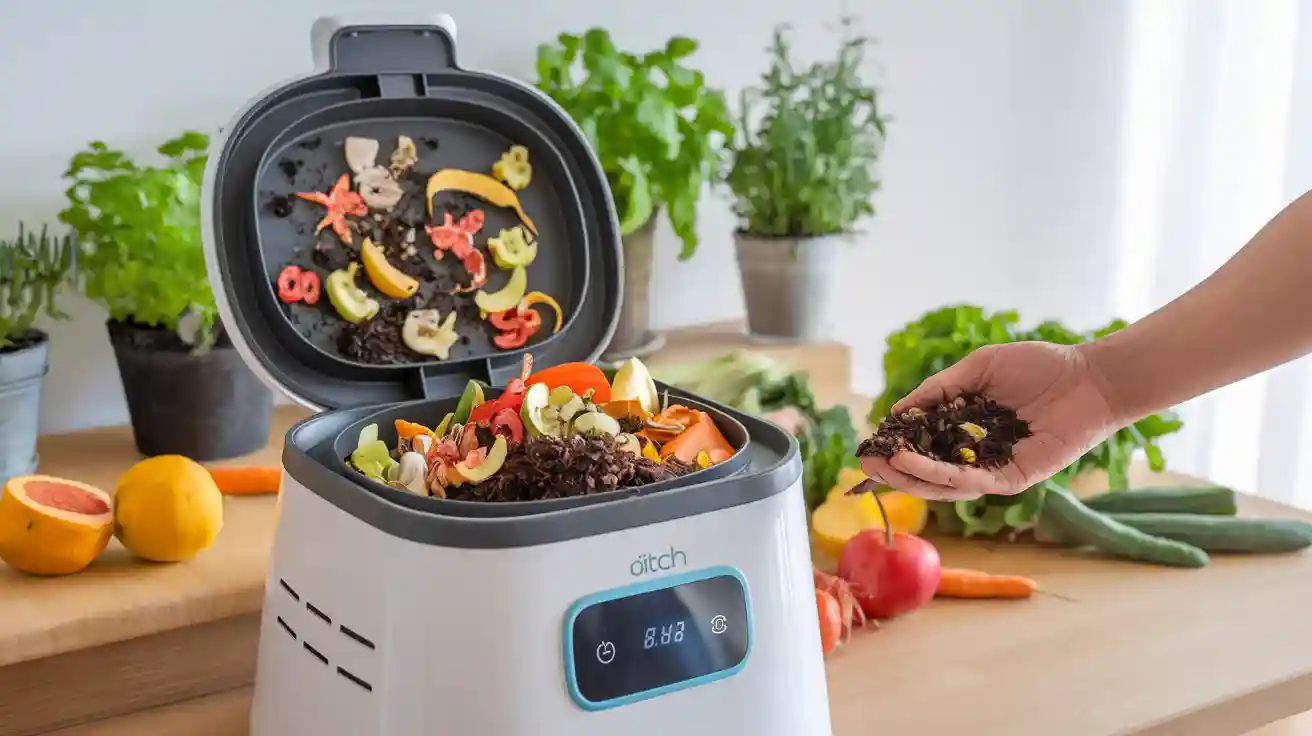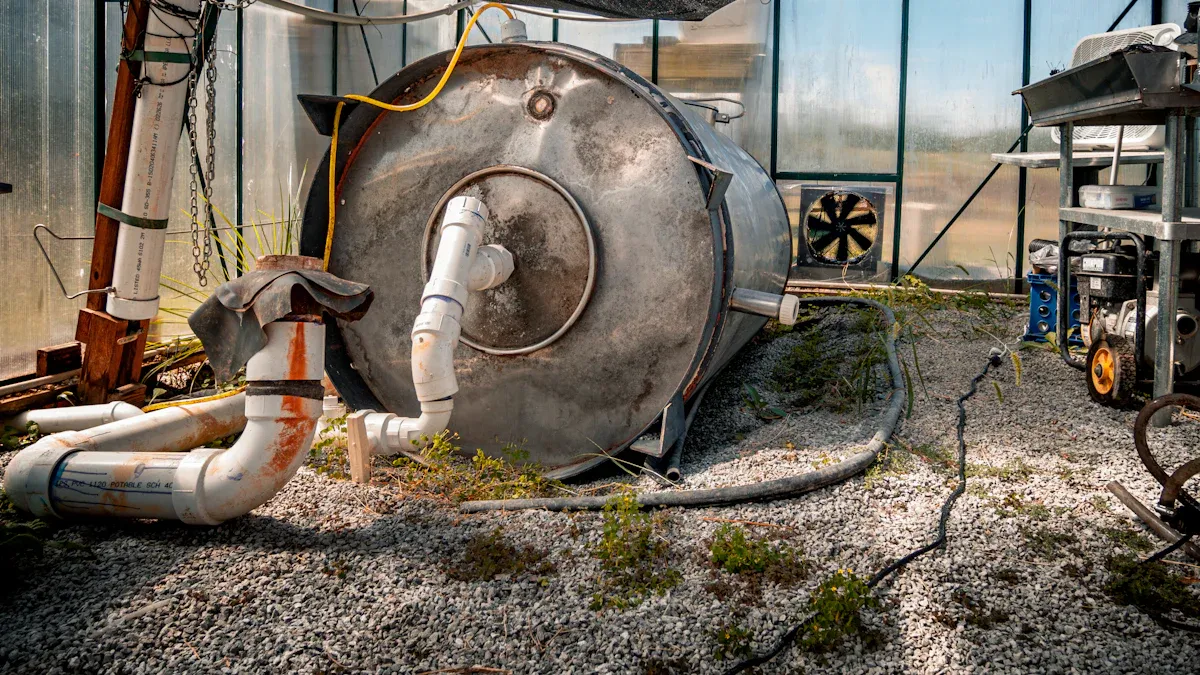
Electric compost technology transforms waste management by turning food scraps into compost quickly. Composting machines use advanced systems to speed up composting. Recent studies show electric compost can create compost in just 48 hours, while traditional composting takes months or even years. These composting machines offer reliable composting solutions for homes and businesses. Electric compost improves waste management and protects the environment by reducing landfill use. Composting machines support better waste management and make composting easy for everyone.
Electric Compost and Composting Machines Explained

How Food Waste Composting Machines Work
Food waste composting machines use advanced technology to turn organic waste into compost quickly. These machines have several main components that work together to speed up food waste composting.
- A heating element raises the temperature of food scraps to about 160°F. This step kills harmful germs and weed seeds.
- A grinding mechanism breaks down dried food into small granules, making it easier for microbes to work.
- A cooling system lowers the temperature before users remove the finished compost.
- A carbon filter removes odors and keeps the air clean during the drying process.
- A user interface, such as a button or app, starts the composting cycle.
Food waste composting machines follow three main stages: heating, grinding, and cooling. Some models tumble the waste during heating, which helps dry the material faster. Others have separate compartments for continuous loading. Modern composting machines also shred or chop organic waste, increasing the surface area for microbes. They mix the waste to spread air and moisture evenly. Rotating drums or tumblers keep the material moving, which helps oxygen reach all parts of the compost. These steps create the best conditions for fast food waste composting.
Electric Compost vs. Traditional Food Waste Composting
Electric compost offers a much faster way to handle food waste composting than traditional methods. Traditional composting often takes months to break down organic waste. Electric compost can turn scraps into compost in just 24 to 48 hours. Traditional methods depend on weather and need regular turning and checking. Composting machines work indoors and run all year, making them easy to use. They need little maintenance and control odors with sealed systems. Food waste composting machines suit small to medium households, while traditional composting works best for large gardens. Electric composting machines cost more at first but save time and effort. The table below shows the main differences:
| Feature | Electric Composting | Traditional Composting |
|---|---|---|
| Breakdown Time | 6-8 hours for most leftovers | Weeks to months |
| Finished Compost Time | Weeks | Months |
| Location | Indoor use | Outdoor space needed |
| Maintenance | Minimal, automated | Regular turning needed |
| Odor Control | Minimal odor | Needs odor management |
| Waste Capacity | Small to medium households | Large-scale, big gardens |
| Cost | Higher initial, low running | Low setup, almost free |
Food waste composting machines make composting simple, fast, and clean. They help people manage organic waste at home or work, supporting better food waste composting for everyone.
The Science Behind Rapid Decomposition in Food Waste Composting Machines
Electric composting machines use a combination of mechanical, biological, and chemical processes to speed up the natural process of decomposition. These machines create the perfect environment for food waste to break down quickly and safely, turning scraps into valuable compost for soil.
Mechanical Processing: Shredding and Mixing
Mechanical shredding and mixing play a key role in the rapid decomposition of food waste. When the machine shreds food scraps into smaller pieces, it increases the surface area available for microbes. This allows microorganisms to work more effectively and accelerates the natural process of decomposition. Mixing the materials ensures that air and moisture spread evenly, which prevents clumping and compaction. Regular turning also supplies oxygen, supporting aerobic microbial activity and helping to accelerate the natural process.
- Shredding increases surface area for microbial activity.
- Smaller particles prevent clumping and improve decomposition.
- Mixing creates a uniform compost mixture and helps break down pathogens.
- Turning aerates the compost, speeding up the natural process of decomposition.
Proper shredding and mixing not only speed up decomposition but also reduce odors and keep pests away. These steps make sure the compost pile stays healthy and active.
Biological Decomposition: Microbial and Enzyme Action
The role of microorganisms is central to the natural process of decomposition in electric composting machines. Special blends of microbes, like those used in the GEME electric composter, break down a wide range of organic waste, including animal proteins and compostable plastics. These microbes secrete enzymes that help digest kitchen waste, making biological decomposition much faster. Machines often use a rotating shaft to mix the waste, which increases contact between microbes, air, and food scraps. This process can reduce waste volume by up to 90% and produce nutrient-rich compost for soil.
Some composters focus on continuous microbial action, producing true finished compost. Others rely more on heat and mechanical agitation, which may not result in fully mature compost. Microbial systems also help control odors and improve the efficiency of decomposition, making the process cleaner and more effective.
Chemical Reactions: Carbon-Nitrogen Ratio, pH, and Moisture
Chemical reactions inside the composting machine are vital for efficient decomposition. The balance of carbon and nitrogen, known as the carbon-nitrogen ratio, provides energy and nutrients for microbes. An ideal ratio, usually around 30:1, supports rapid microbial growth and speeds up the natural process of decomposition. Moisture content is also important. Too much moisture can cause anaerobic conditions, slowing decomposition and causing odors. Too little moisture can stop microbial activity.
The table below shows how different factors affect decomposition:
| Parameter | Method/Condition | Effect on Decomposition Efficiency |
|---|---|---|
| Carbon-Nitrogen Ratio | Feedstock selection (C/N 15–30) | Supports microbial activity and balanced decomposition |
| Moisture Content | Bulking agents, periodic turning | Promotes evaporation, prevents compaction, improves aeration |
| pH | Monitoring changes from acidic to near-neutral | Shows compost maturity and stable microbial activity |
| Aeration | Perforations, manual or automatic turning | Increases oxygen, prevents anaerobic zones, speeds decomposition |
Electric composting machines manage these factors by controlling aeration, mixing, and feedstock selection. Some machines use high temperatures to dehydrate waste, which reduces volume and odor but may require extra curing for full decomposition. Maintaining the right chemical balance ensures the natural process of decomposition continues smoothly.
Heat Generation and Temperature Control
Heat plays a major role in the rapid decomposition of food waste. Electric composting machines raise the temperature to between 131°F and 160°F, creating the best conditions for microbes to thrive and destroy harmful germs. The thermophilic stage, where temperatures reach 40-60°C (104-140°F), is especially important for breaking down tough materials and killing pathogens. Machines use aeration and turning to control heat levels, making sure the compost does not overheat. If temperatures go above 65°C (149°F), beneficial microbes can die, slowing the natural process of decomposition.
As the compost cools, different microbes take over and continue the natural process of decomposition at lower temperatures. This careful temperature control helps maintain a steady rate of decomposition and produces high-quality compost for soil.
Tip: Proper temperature control not only accelerates the natural process of decomposition but also ensures the compost is safe and free from harmful organisms.
The science behind electric composting machines shows how mechanical, biological, and chemical processes work together to accelerate the natural process of decomposition. By managing shredding, mixing, microbial action, chemical balance, and heat, these machines turn food waste into valuable compost quickly and efficiently.
Practical Benefits of Electric Compost Technology

Environmental Impact of Food Waste Composting
Electric composting machines help protect the environment by reducing the amount of organic waste sent to landfills. These machines turn kitchen scraps into nutrient-rich compost, which supports urban agriculture and landscaping. By using a food waste composting machine, households and businesses lower greenhouse gas emissions and promote sustainable waste management. Composting also helps close resource loops, making cities cleaner and greener. The environmental benefits of composting include less landfill waste and healthier soil for plants.
Convenience and Ease of Composting Machines
Composting machines make food waste composting simple for everyone. Users enjoy features like automatic lids, easy controls, and compact designs. Many models allow continuous feeding of organic waste, so people do not need to wait for a batch to finish. These machines work indoors, saving space and keeping kitchens clean. The process requires little effort, making composting accessible to busy families and offices. Composting machines also reduce pests and keep the environment odor-free.
Speed and Efficiency of Electric Compost
Electric composting machines process organic waste much faster than traditional methods. Some models, like the Reencle Prime, can turn food scraps into compost in as little as 12 hours. Most food waste composting machines finish the job within a day, while traditional composting takes months. This rapid decomposition supports efficient waste processing and helps users manage waste quickly. The high-quality compost produced can enhance soil fertility and support healthy plant growth.
Odor Control in Food Waste Composting
Odor control is a key advantage of electric composting. Composting machines use carbon filters, airtight lids, and special deodorization systems to prevent unpleasant smells. These features make food waste composting possible indoors without bothering anyone. Machines also use aerobic decomposition, which reduces methane and keeps the air clean. Regular filter changes and temperature control help maintain a fresh environment.
Versatility: What Food Waste Composting Machines Can Process
Modern composting machines handle a wide range of organic waste. They can process fruit, vegetables, meat, dairy, and even small bones. Some models use microbes and heat to break down tough materials, while others offer bacteria packets for better decomposition. This versatility means users can compost more types of food scraps, reducing overall waste. The finished product is often a soil-like amendment that supports nutrient-rich soil and high-quality compost for gardens.
Composting machines offer many advantages, including rapid waste management, environmental benefits of composting, and efficient waste processing for homes and businesses.
Electric compost technology changes how people manage food waste.
- Electric composters create compost in hours, not months, and keep the environment clean with odor-free operation.
- These machines support sustainability by reducing landfill waste and promoting sustainable practices.
- Electric composting helps everyone adopt sustainability and enrich soil with compost.
FAQ
How do composting machines accelerate the natural process of decomposition?
Composting machines shred organic waste and control temperature. They use the role of microorganisms and biological decomposition to accelerate the natural process. This technology creates nutrient-rich compost quickly.
What are the main advantages of using a food waste composting machine?
A food waste composting machine offers efficient waste processing, odor control, and high-quality compost. It supports sustainable practices and sustainable waste management. Users see environmental benefits of composting at home.
Can modern composting machines enhance soil fertility and support sustainability?
Modern composting machines produce nutrient-rich compost. This compost improves nutrient-rich soil and enhances soil fertility. These composting solutions help the environment and promote sustainability in waste management.


